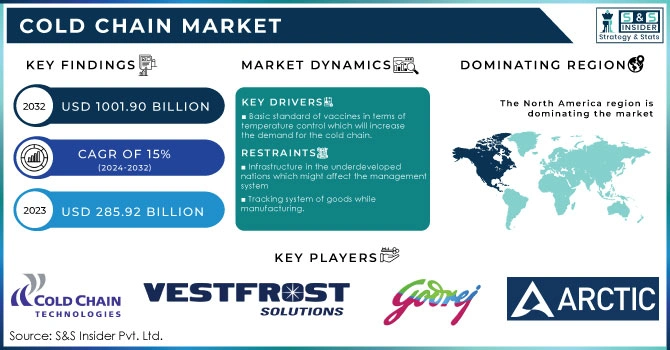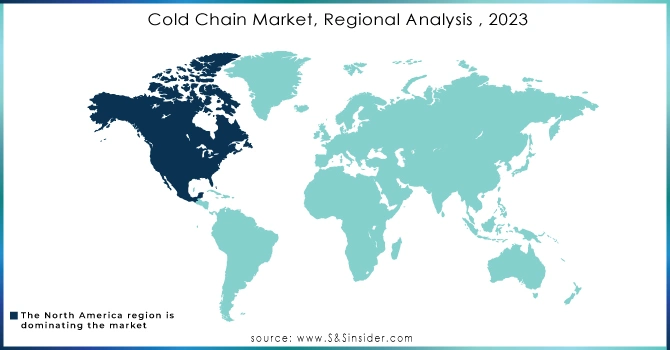Cold Chain Market Report Scope & Overview:

To Get More Information on Cold Chain Market - Request Sample Report
The Cold Chain Market Size was valued at USD 285.92 billion in 2023 and is projected to grow to USD 1001.90 billion by 2032, with an impressive compound annual growth rate (CAGR) of 15% from 2024 to 2032
The sudden rise in the demand for the cold chain because of the outbreak of covid 19 will be considered as the driving factor of the cold chain market, vaccines should be kept at a certain temperature till the time they are manufactured to use if the temperature is too high or too low it can get damaged these factors increase the demand for the cold chain, there are certain rules and guideline imposed by the WHO and all the activities regarding the use of raw materials, freezers and vaccine carriers which every company must follow, the initiatives taken by the World health Organization (WHO) of immunization all around the globe is also the factor which will drive the growth of the cold chain market, Cold chain will define the quality of the vaccines as the matter of fact that the vaccines are exported and imported via number of transportation ways and in that the chances of vaccines getting damaged is high so this is where the demand for the cold chain management increases, The immunization agenda 2030 in which the basic objective of the WHO is to make sure that everyone gets vaccinated for good health and everyone should get immunized so that their body can prevent against various disease, Cold chain is one of the main element of the WHO strategic plans in which the major role of the cold chain will be to ensure that the vaccines are delivered at the right time to the right place and in a proper quality, this is where the demand for the cold chain increases, The increasing initiatives taken by the key players to expand the marketplace and also the initiatives taken by the organizations in favour of cold chain management because of the rising demand can drive the cold chain market in the future. There is certain temperature in which vaccines should be kept and for that the technical support and management in terms of refrigerators need to be at its best, This report will give a brief information which will include the qualitative and quantitative data to support the facts and statements.
Impact of COVID-19
COVID-19 had a positive and challenging impact on the cold chain management, The demand for the vaccines all around the globe was the positive impact for the cold chain market, but it was challenging for the underdeveloped regions, where the lack of infrastructure which affects the cold chain management and also the temperature issues which surely affects the vaccines was the major challenges the cold chain management has the face, Countries which manufactured vaccines also had to face the problems related to the meeting the nations demand and also exporting to the other countries and where the demand for the cold chain got into a limelight because almost every vaccine had a basic standard regarding temperature freezing maintained until they are used for vaccination which created a challenge for the value chain as they had to adapt the new culture where innovation had to be introduced to meet the demand and to make sure no damage is been done to the vaccines.
Market Dynamics
Drivers
-
The rise in the demand for the vaccines all around the globe.
-
Basic standard of vaccines in terms of temperature control which will increase the demand for the cold chain.
Restrains
-
Infrastructure in the underdeveloped nations which might affect the management system
-
Tracking system of goods while manufacturing.
Opportunity
-
The government policy and support to the cold chain.
-
Continuous upgradation and technological advancement by the key players.
Post covid the rise in the investment and the launch of the products during covid 19 and post covid assures the opportunity for the cold chain market as the new vaccines requires a good quality supply chain infrastructure to maintained its quality and at the same time deliver the results because the import and export factor all around the globe should not impact the quality of the vaccines or any other drugs and because of the which the demand for the cold chain management will be high during the forecasted period.
Challenge
-
To maintain the quality of products while transportation.
The cases reported during the covid 19 as because of the poor supply chain management there was loss of vaccine doses which further puts the pressure on the key players to make sure to manage the new launches to meet the demand for the vaccines because every vaccines have its own basic standard and which is been approved by the FDA.
Impact of Recession
Recession impacts the supply chain management as the inflation rates varies and also the economic condition of the developed and the underdeveloped gets affected which leads to unemployment, rise in the prices of raw materials , transportation expenses, all the mentioned factor affect the cold chain management in a negative way, but also the fact that the demand for the vaccines all around the globe will keep the demand high for the cold chain management government schemes and policy and also the support for cold chain management will be the positive elements. Every nation economic condition will be different during the recession so it will all depend on the key players, organizations and government of that respective nations what decisions and how to run the logistics with minimizing the effect of recession.
Impact of Russia Ukraine War
The Russia Ukraine war had a major effect on the prices and the shortage of the supply for the company’s which were dependent on the Ukraine manufacturers, the war led to the disruption of global supply chain management specially for the easter European nations, this war had effect on the infrastructure, prices of transportation and oil and gases, the above affect directly has a negative impact on the supply chain management.
Key Market Segmentation
By Product
-
Refrigerators
-
Ultra-low Temperature Freezers
-
Shipping Solutions
-
Parcel Solutions
-
Pallet Solutions
-
-
Refrigerants
-
Insulated Containers
-
Temperature Monitoring Products
-
Indicators
-
Data Loggers
-
Others
-
-
Packaging
-
Others
By End Users
-
Logistics & Warehouse Companies
-
Food & Beverages Companies
-
Pharmaceutical Companies
-
Cosmetics Companies
-
Others
Regional Analysis:
North America is said to be the region which will dominate the region with the increase of innovation and the continuous government support in healthcare industry and the demand for the vaccinations in the developed regions of the North America region is the driving factor which will impact the north America in a positive manner.
Europe will also show a good growth during the forecasted period as several polices and government initiatives in favour of cold chai management to promote and the creating basic standards with keeping the security and risks element on a prior list.
APAC will show a rapid growth because of the continues technological advancement and the rising demand for the vaccines in all parts of APAC

Do You Need any Customization Research on Cold Chain Market - Inquire Now
Key Players:
The major key players are Cold Chain technologies, Vestfrost Solutions, Godrej, Arctic Refrigeration., Sofrigam, CoolMed Ltd, Pelican BioThermal LLC, Softbox, Sealed Air Corporation, Others
Recent Developments
-
The launch of Bio I-Care Series by Vestfrost solutions which offers new features and reliable cooling performance, along with the added touch screen which will help the customers to get the data and information which they need.
-
With the rising demand for the vaccines during the covid 19 and the poor supply chain management which was causing the vaccines to go in vain the initiative taken by the Sofrigram and logmore had joined forces to develop intelligent and qualified temperature controlled packaging which will beneficial for the vaccinees supply chain as per the WHO guidelines there are certain basic standards given by the or g regarding the maintain eve of the vaccines y the date of manufacturing to the date of vaccinations e.g. Pfizer’s vaccines needs constant freezing of -70⁰C,
-
The launch of CREDO go cold Chain shipping Solution by Pali Biothermal.
| Report Attributes | Details |
| Market Size in 2022 | US$ 285.92 Billion |
| Market Size by 2032 | US$ 1001.90 Billion |
| CAGR | CAGR of 15% From 2023 to 2032 |
| Base Year | 2022 |
| Forecast Period | 2023-2032 |
| Historical Data | 2020-2022 |
| Report Scope & Coverage | Market Size, Segments Analysis, Competitive Landscape, Regional Analysis, DROC & SWOT Analysis, Forecast Outlook |
| Key Segments | • By Product (Refrigerators, Ultra-low Temperature Freezers, Shipping Solutions, Refrigerants, Insulated Containers, Temperature Monitoring Products, Packaging, Others) • By End Users (Logistics & Warehouse Companies, Food & Beverages Companies, Pharmaceutical Companies, Cosmetics Companies, Others) |
| Regional Analysis/Coverage | North America (USA, Canada, Mexico), Europe (Germany, UK, France, Italy, Spain, Netherlands, Rest of Europe), Asia-Pacific (Japan, South Korea, China, India, Australia, Rest of Asia-Pacific), The Middle East & Africa (Israel, UAE, South Africa, Rest of Middle East & Africa), Latin America (Brazil, Argentina, Rest of Latin America) |
| Company Profiles | Cold Chain technologies, Vestfrost Solutions, Godrej, Arctic Refrigeration., Sofrigam, CoolMed Ltd, Pelican BioThermal LLC, Softbox, Sealed Air Corporation, Others |
| Key Drivers | • The rise in the demand for the vaccines all around the globe. • Basic standard of vaccines in terms of temperature control which will increase the demand for the cold chain. |
| Market Opportunities | • The government policy and support to the cold chain. • Continuous upgradation and technological advancement by the key players. |

